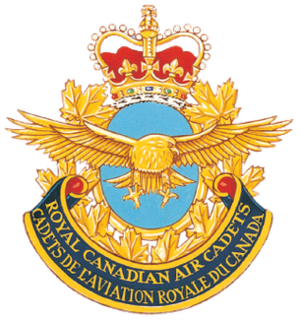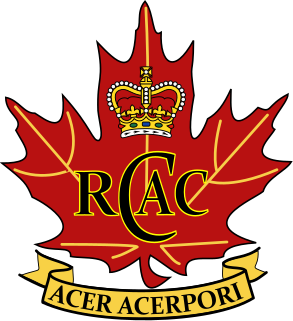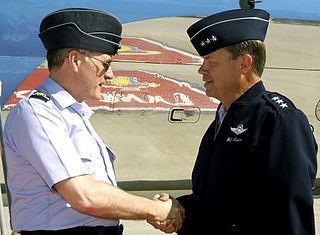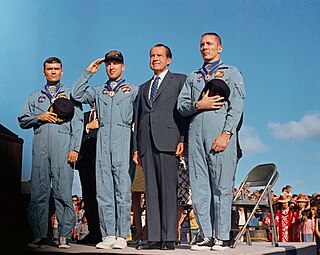
Group captain is a senior commissioned rank in the Royal Air Force, where it originated, as well as the air forces of many countries that have historical British influence. It is sometimes used as the English translation of an equivalent rank in countries which have a non-British air force-specific rank structure. Group captain has a NATO rank code of OF-5, meaning that it ranks above wing commander, immediately below air commodore and is the equivalent of the naval rank of captain and the rank of colonel in other services.

The Combined Cadet Force (CCF) is a youth organisation in the United Kingdom, sponsored by the Ministry of Defence (MOD), which operates in schools, and normally includes Army, Royal Navy and Royal Air Force sections. Its aim is to "provide a disciplined organisation in a school so that pupils may develop powers of leadership by means of training to promote the qualities of responsibility, self reliance, resourcefulness, endurance and perseverance".

The Air Training Corps (ATC) is a British volunteer-military youth organisation. They are sponsored by the Ministry of Defence and the Royal Air Force. The majority of staff are volunteers, and some are paid for full-time work – including Commandant Air Cadets, a Full Term Reserve Service RAF officer. Although many ATC cadets go on to join the RAF or other services, the ATC is not a recruiting organisation for its parent service.

The Royal Canadian Air Cadets is a Canadian national youth program for young individuals aged 12 to 18. Under the authority of the National Defence Act, the program is administered by the Canadian Forces (CF) and funded through the Department of National Defence (DND). Additional support is provided by the civilian Air Cadet League of Canada (ACL). Together with the Royal Canadian Sea Cadets and Royal Canadian Army Cadets, it forms the "largest federally funded youth program in the country". Cadets are not members of the military and are not obliged to join the Canadian Forces.

The Royal Canadian Army Cadets is a national Canadian youth program sponsored by the Canadian Armed Forces and the civilian Army Cadet League of Canada. Under the authority of the National Defence Act, the program is administered by the Canadian Armed Forces and funded through the Department of National Defence. Additionally, the civilian partner of the Royal Canadian Army Cadets, the Army Cadet League of Canada, also ensures financial, accommodations and transportation support for RCAC programs and services at a community level.
Officer Cadet is a rank held by military cadets during their training to become commissioned officers. In the United Kingdom, the rank is also used by members of University Royal Naval Units, University Officer Training Corps and University Air Squadron; however, these are not trainee officers with many not choosing a career in the armed forces.

The Royal Canadian Sea Cadets is a Canadian national youth program sponsored by the Canadian Armed Forces and the civilian Navy League of Canada. Administered by the Canadian Forces, the program is funded through the Department of National Defence, with the civilian partner providing support in the local community. Cadets are not members of the Canadian Armed Forces.

Mess dress uniform is the most formal type of uniforms used by military personnel, police personnel, and other uniformed services members. It frequently consists of a mess jacket, trousers, white dress shirt and a black bow tie, along with orders and medals insignia. Design may depend on regiment or service branch, e.g. army, navy, air force, marines, etc. In Western dress codes, mess dress uniform is the supplementary alternative equivalent to the civilian black tie for evening wear or black lounge suit for day wear although military uniforms are the same for day and evening wear. Mess dress uniforms are typically less formal than full dress uniform, but more formal than service dress uniform.

Insignias and badges of the United States Navy are military badges issued by the United States Department of the Navy to naval service members who achieve certain qualifications and accomplishments while serving on both active and reserve duty in the United States Navy. Most naval aviation insignia are also permitted for wear on uniforms of the United States Marine Corps.

A side cap is a military cap that can be folded flat when not being worn. It is also known as a garrison cap or flight cap in the United States, wedge cap in Canada, or field service cap in the United Kingdom. In form the side cap is comparable to the glengarry, a folding version of the Scottish military bonnet. It has been associated with various military forces since the middle of the 19th century, as well as various civilian organizations.

The peaked cap, peaked hat, service cap, barracks cover or combination cap is a form of headgear worn by the armed forces of many nations, as well as many uniformed civilian organisations such as law enforcement agencies and fire departments. It derives its name from its short visor, or peak, which was historically made of polished leather but increasingly is made of a cheaper synthetic substitute.

The awards and decorations of Civil Air Patrol are "designed to recognize heroism, service, and program achievements" of members of Civil Air Patrol (CAP) of the United States of America. The CAP is the official auxiliary of the United States Air Force. These awards are made to improve the esprit de corps of members. These awards are all worn in the form of medals or ribbons and all are considered civilian decorations. Civil Air Patrol regulations allow them to only be worn and displayed on appropriate CAP uniforms. In order to be considered for one of these awards, an individual must be a member in good standing of Civil Air Patrol at the time of the act being recognized. There is a statute of limitations for these awards and all recommendations must be submitted within 2 years of the act being performed. It is possible for the next of kin of deceased persons to be presented awards to which a member was entitled, but which he or she did not receive. Award review boards are established at the region, wing, group, and squadron levels to consider recommendations for all awards and decorations.

A necklet is a type of decoration which is designed to be worn and displayed around a person's neck, rather than hung (draped) from the chest as is the standard practice for displaying most decorations.

The Australian Air Force Cadets (AAFC), known as the Air Training Corps (AIRTC) until 2001, is a Federal Government funded youth organisation. The parent force of the AAFC is the Royal Australian Air Force (RAAF). Along with the Australian Army Cadets (AAC) and the Australian Navy Cadets (ANC), it is part of the Australian Defence Force Cadets.

The Lord Strathcona Medal, is the highest award which can be bestowed upon a Canadian cadet in recognition of exemplary performance in physical and military training.

The Royal Montserrat Police Service is the police service of the British Overseas Territory island of Montserrat in the Caribbean. The current Commissioner is Steve Foster, JP, BSc, CPA., a native and career police officer of Montserrat.
This article describes the use of the beret as part of the uniform of various organizations. The use of the beret as military headgear is covered in a dedicated article, Military beret.
The Sea Cadet Service Medal is a Canadian Sea Cadet medal, which is awarded to Cadets who have completed at least four years of continuous service in the Canadian Cadet Organization. Recipients of the Sea Cadet Service Medal must be in the sea element at the time of receiving the award, though time spent in army or air cadets also counts towards the award. Time spent in other Royal Canadian Sea Cadet corps also counts towards the medal. Cadets can only receive one service medal, even if they have spent a total of four years in sea, army and air cadets.

The Battlefords Army Cadets is a free youth program open to youth aged 12 – 18 sponsored by the Canadian Forces and the civilian Army Cadet League of Canada. 2537 Battlefords Army Cadets are affiliated with the North Saskatchewan Regiment and cadets may wear the badges and accoutrements of the affiliated unit.
The 2784 Governor General's Foot Guards Royal Canadian Army Cadet Corps is an Ottawa-based paramilitary youth program jointly-sponsored by the Canadian Forces and the Army Cadet League of Canada. The cadets, as their name implies, are affiliated with the Governor General's Foot Guards (GGFG), which is one of three Royal Household Division regiments in the Canadian Army. As an affiliated unit, the cadets may wear the badges of the GGFG. The cadet corps currently parade at Cartier Square Drill Hall alongside their GGFG counterparts and The Cameron Highlanders of Ottawa.

















